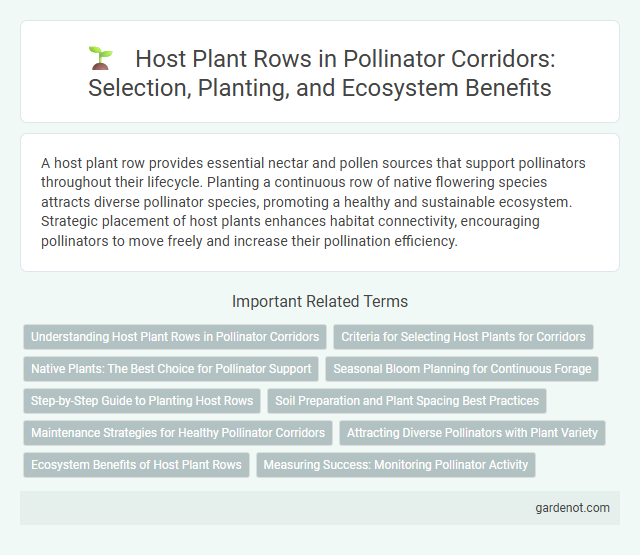A host plant row provides essential nectar and pollen sources that support pollinators throughout their lifecycle. Planting a continuous row of native flowering species attracts diverse pollinator species, promoting a healthy and sustainable ecosystem. Strategic placement of host plants enhances habitat connectivity, encouraging pollinators to move freely and increase their pollination efficiency.
Understanding Host Plant Rows in Pollinator Corridors
Host plant rows serve as essential components in pollinator corridors by providing targeted floral resources that support diverse pollinator species. These rows are strategically planted with native and nectar-rich plants to enhance habitat connectivity and promote effective pollinator movement across fragmented landscapes. Understanding the plant species composition and bloom periods within host plant rows is crucial for maximizing their ecological benefits and sustaining pollinator populations.
Criteria for Selecting Host Plants for Corridors
Selecting host plants for pollinator corridors requires prioritizing native species that provide nectar and pollen throughout multiple seasons, ensuring continuous food sources for diverse pollinators. Plants should have high floral density and bloom periods staggered to support early, mid, and late-season pollinators, including bees, butterflies, and hummingbirds. Resilience to local climate conditions and minimal maintenance requirements are critical to sustain long-term corridor effectiveness and habitat stability.
Native Plants: The Best Choice for Pollinator Support
Native plants serve as the optimal host plant row in pollinator corridors due to their co-evolution with local pollinators, providing essential nectar and pollen resources tailored to native bee species, butterflies, and other beneficial insects. These plants enhance habitat connectivity while promoting biodiversity and improving ecosystem resilience by supporting specialized pollinators that non-native species often cannot sustain. Incorporating native species into host plant rows fosters robust pollinator populations, crucial for the health of agricultural landscapes and natural ecosystems.
Seasonal Bloom Planning for Continuous Forage
Host plant rows in pollinator corridors are strategically designed to provide continuous forage by selecting species with staggered bloom periods. Seasonal bloom planning ensures a succession of flowering plants from early spring through late fall, supporting diverse pollinator species throughout their active seasons. Incorporating native perennials, annuals, and shrubs with varied flowering times maximizes nectar and pollen availability, enhancing overall pollinator health and corridor effectiveness.
Step-by-Step Guide to Planting Host Rows
Planting a host plant row requires selecting native species that serve as critical larval food sources for butterflies and pollinators. Begin by preparing the soil with organic compost to enhance nutrient availability and ensure excellent drainage. Space plants according to their mature size, water regularly during establishment, and monitor for pests to create a thriving pollinator corridor.
Soil Preparation and Plant Spacing Best Practices
For optimal pollinator corridor success, soil preparation should involve deep tilling and organic matter incorporation to ensure nutrient-rich, well-drained soil. Host plants must be spaced at least 12 to 18 inches apart to promote healthy root growth and reduce competition for resources. Proper spacing and soil quality enhance plant vigor, attracting diverse pollinator species and supporting corridor sustainability.
Maintenance Strategies for Healthy Pollinator Corridors
Maintaining host plant rows involves regular pruning, weed control, and monitoring for pest infestations to ensure optimal growth and flowering that support diverse pollinator species. Implementing mulch layers and organic fertilizers promotes soil health and water retention, vital for sustained plant vigor in pollinator corridors. Seasonal assessments enable adaptive management, enhancing plant resilience and continuous nectar and pollen availability for pollinator populations.
Attracting Diverse Pollinators with Plant Variety
Planting diverse host plant rows significantly enhances pollinator corridor effectiveness by supporting a wide range of pollinators such as bees, butterflies, and beetles. Including varying flowering species like milkweed, goldenrod, and native wildflowers ensures continuous blooming periods and diverse nectar sources. This rich plant variety creates optimal habitats that promote pollinator health, reproduction, and biodiversity conservation.
Ecosystem Benefits of Host Plant Rows
Host plant rows enhance pollinator corridors by providing essential food resources and habitat for native pollinators, promoting biodiversity and ecosystem resilience. These plantings support the reproduction of pollinators such as bees and butterflies by supplying nectar, pollen, and nesting materials, resulting in increased pollination services for adjacent crops and wild plants. The presence of diverse host plants in linear arrangements aids in maintaining genetic diversity and stabilizing local ecosystems against environmental stressors.
Measuring Success: Monitoring Pollinator Activity
Measuring success in a pollinator corridor's host plant row involves systematically monitoring pollinator activity through consistent visual surveys and digital tracking methods like automated cameras or RFID tagging. Key metrics include the frequency of pollinator visits, species diversity, and pollination rates, which provide valuable insights into ecosystem health and corridor effectiveness. Data collected guides adaptive management strategies to enhance habitat quality and ensure sustained pollinator populations.
Host plant row Infographic

 gardenot.com
gardenot.com